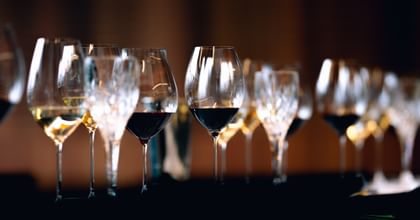Stemmed or Stemless?
Why Do Wine Glasses Have Stems?

Imagine a typical wine glass. Are you seeing something with an elegant long stem? While RIEDEL’s stemless series, The O Wine Tumbler, has been one of our most popular collections since its introduction in 2004, there’s no doubt that stemmed glassware remains the standard. So how did it get its shape, and why do wine glasses have a stem?

The architecture of stemware
A modern wine glass consists of three architectural features: the bowl, the stem, and the base.
Unlike other glasses, RIEDEL’s Grape Varietal Specific stemware features finely-tuned bowls designed to highlight and emphasise the characters of particular wine varieties. They are based on three variables (shape, size, and rim diameter) to translate the "message" of wine to the human senses.
The height of the stem and the width of the base are critical to creating a balanced and enjoyable glass to hold. Your glass doesn’t necessarily have to feature a very long or extra thin stem, as long as it is in proportion to its base.

How glassware got its shape
This style of glass for wine originated in the 1400s, in the world’s capital of glassmaking, Venice. Wine previously was drunk from a variety of different cups, made from anything from wood to leather, pottery to pewter.
The discovery and use of cristallo glass on the island of Murano in Venice, which was the first colourless glass, elevated the look of glassware. The basic form of the modern glass is said to have been based on the religious chalice, which comprised of the bowl, stem, base architecture as we know it now. But the stem also had the advantage of protecting wine’s temperature from the tradition of cupping hands around the bowl.

A stem helps you swirl wine
Swirling wine is a common part of wine drinking for many people, but there is a common misconception about why we do it. Many believe it’s for aeration, like a one-glass version of decanting, but a swirl isn’t vigorous enough to have the same affect.
So why do we swirl wine? Swirling wine is really just to help invigorate aromas within your glass. This small movement will heighten the intensity of aroma and give you a better expression of flavour.
Either way, a stemmed glass is much easier to elegantly swirl than one without.

How to hold a wine glass (properly)
There’s one major aesthetic benefit to having a stem on your wine glass: it will give you something to hold onto other than the bowl. As we've said, a well-designed wine glass should feel perfectly balanced when held in the right way - that is, by the stem.
Where you hold it on the stem depends on the length of the stem and the size of the bowl (and making sure you don't overpour your glass so it's top heavy!), but generally, the midway point is ideal. Simply grip it firmly but lightly with your thumb and first two fingers. Plus there’s nothing less visually appealing than getting to the end of your evening with a smudged, greasy wine glass that shows every piece of food you may have touched.
So if you've been wondering how to hold a wine glass for maximum elegance, a long stemmed glass is your answer as it will continue looking good regardless of how your evening plays out.
Locations